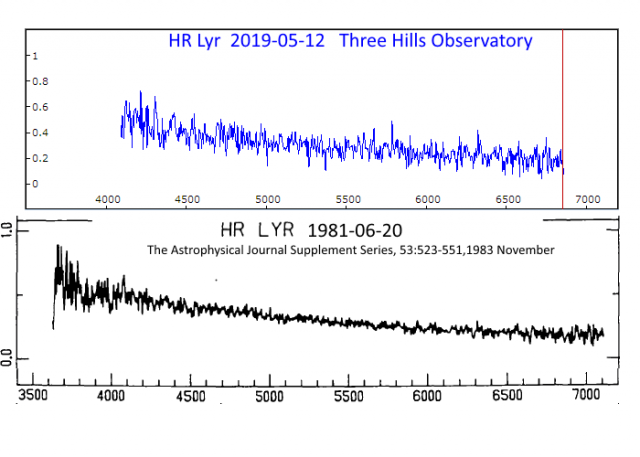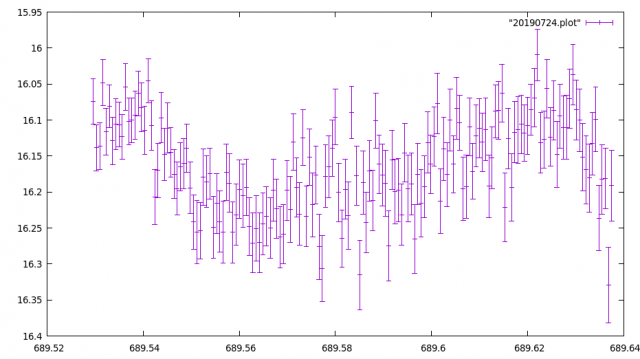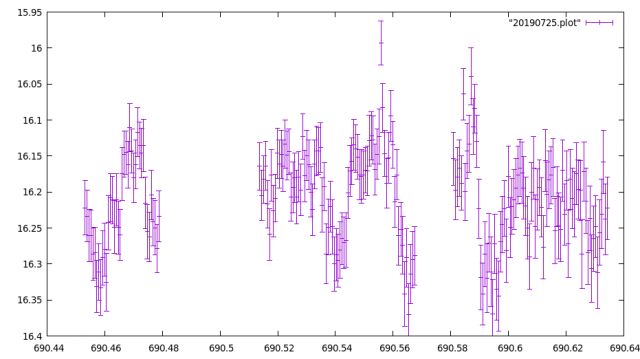› Forums › Variable Stars › Campaign to observe HR Lyrae
- This topic has 16 replies, 6 voices, and was last updated 6 years ago by
 Jeremy Shears.
Jeremy Shears.
-
AuthorPosts
-
12 April 2019 at 3:58 pm #574306
 Jeremy ShearsParticipant
Jeremy ShearsParticipantWith Lyra becoming well placed for observation until the end of the year (at least in the northern hemisphere), we are launching a campaign to observe this old nova in quiescence. Coincidentally, this year is the centenary of the discovery of Nova Lyrae on 1919 December 6 by Miss Mackie at the Harvard College Observatory.
We are looking for nightly snapshot photometry (CCD or visual). In addition, some long time series photometry runs would be helpful. Spectroscopy is also desirable, but this will be a real challenge given the magnitude. I last observed it at V = 15.6 on April 1 at mag with the AAVSOnet’s SRO telescope.
Full details about the campaign, what is already known about HR Lyr and what we are seeking to discover about the star are available on the BAA website.
The campaign will continue until the end of the year
Jeremy Shears
10 May 2019 at 5:27 pm #581050 Jeremy ShearsParticipant
Jeremy ShearsParticipantWe are now one month into the campaign and, whilst it’s still early days, it’s good to see the first data coming in. Many thanks to: David Boyd, Walter Cooney, Sjoerd Dufoer, Ian Miller, Ken Menzies, Martin Mobberley, Roger Pickard and Gary Poyner.
The star has varied between mag 15.4 and 16.2. Time series photometry by Roger Pickard and Ken Menzies has shown various humps and bumps in the light curve, but it’s too early to determine if they are periodic.
With Lyra becoming more accessible in the evening sky, I hope that further observations will begin to flow in. Do feel to join in the campaign. We are looking for nightly snapshot photometry to determine the overall shape of the light curve and well as some multi-hour photometry runs to look for short-term periodicities.
Further details about the campaign can be found here.
18 May 2019 at 12:36 am #581062 Robin LeadbeaterParticipant
Robin LeadbeaterParticipantA very noisy low resolution ALPY 600 spectrum (It should be possible to do better) is similar to a low resolution 1981 spectrum from the literature.
It shows a blue continuum with no obvious emission lines, though there is a hint of some small features common to both spectra

Cheers
Robin
19 May 2019 at 1:50 pm #581063 Jeremy ShearsParticipant
Jeremy ShearsParticipantMany thanks for getting a spectrum, Robin! I had feared the system might be a little too faint.
3 June 2019 at 8:19 pm #581111 Stewart John BeanParticipant
Stewart John BeanParticipantI obtained the following three results with the T5 telescope ( 250mm reflector) in New Mexico on 26 May. Using a 14.29 mag star as reference, AstroImageJ gives 15.55(V), 15.96(Red) and 15.48(Blue).
Stewart
3 June 2019 at 8:58 pm #581112 Grant PrivettParticipant
Grant PrivettParticipantIn this context, how long is a “long time series”?
3 June 2019 at 9:27 pm #581113 Jeremy ShearsParticipant
Jeremy ShearsParticipantThank you Stewart
3 June 2019 at 9:31 pm #581114 Jeremy ShearsParticipant
Jeremy ShearsParticipantSeveral hours, Grant, probably > 3 (there is a proposed period of 0.1 day, which could set the lower limit for t/series, but I’m doubtful about that). However, such long runs are not possible at these latitudes atm.
6 July 2019 at 4:11 pm #581184 Jeremy ShearsParticipant
Jeremy ShearsParticipantWe are now 3 months into the HR Lyr campaign and we have a nice light curve of this old nova developing. This can be seen on the VSS website. It has been brightening steadily over the last 3 weeks and is now as bright has it has been for a very long while. It will be interesting to see just how bright it becomes.
Time-resolved photometry continues to show various humps and bumps in the light curve with an amplitude of ~0.15 mag. These appear to be fairly regular for a few cycles (~1.5 h), but they do not appear to be consistent. Moreover the shape of the bumps is quite variable.
A couple of requests:
1. Please keep the once-or twice per night snapshot photometry going. New observers are always welcome, of course.
2. Some really long photometry runs (several hours) over a few nights would help us to understand the short term variations and see whether a coherent signal emerges. Late July onwards would be a good time for this as the nights are becoming longer.
Many thanks to all the observers who have supply visual and CCD photometry:
David Boyd, Walter Cooney, Pavol Dubovsky, Sjoerd Dufoer, Carlo Gualdoni, Kevin Hills, Steve Johnston, Mel Joslin, Paul Leyland, JH Mallett, Ian Miller, Ken Menzies, Martin Mobberley, Roger Pickard, Gary Poyner, Jeremy Shears, Dave Smith, Richard Sabo, Tonny Vanmunster, Ivan Walton
Jeremy Shears
7 July 2019 at 6:03 pm #581189 Gary PoynerParticipant
Gary PoynerParticipantI’d urge visual observers to add this object to their programme during this active, high brightness state if you can get through mag 15. I’ve been monitoring HR Lyr since the early 1990’s, and on June 29 this year I recorded it at 15.1 visual – the brightest I’ve ever seen it. Now is an excellent opportunity to actually see this historical Nova for yourself.
Gary
15 August 2019 at 5:20 pm #581268 Jeremy ShearsParticipant
Jeremy ShearsParticipantAn updated light curve covering the campaign up to Aug 9 is shown on the VSS website.
In the last month it’s faded by about a magnitude. Please do keep up nightly observations of the star and if anyone is able to do long CCD photometry runs (a few hours), it would be greatly appreciated.
There will be a more detailed update on the campaign in the next Variable Star Section Circular which is due to appear on Sept 1.
The Circular is emailed free to anyone that requests it – if you are not already on the distribution list please contact me using the “Send Email” button to the left of this message.
15 August 2019 at 6:24 pm #581269 Dr Paul LeylandParticipant
Dr Paul LeylandParticipantYesterday I processed two nights’ data taken by Kevin Hills, 160 and 199 images respectively. They would be in the database by now but a vicious migraine wiped me out for all of today. Still very fragile now.
I’ll have another look for short periodicity.
15 August 2019 at 9:49 pm #581271 Jeremy ShearsParticipant
Jeremy ShearsParticipantThanks Paul. The behaviour looks different on the two nights (I realise the second run was quite a bit longer than the first)
16 August 2019 at 10:42 am #581270 Dr Paul LeylandParticipant
Dr Paul LeylandParticipant

Both nights show fluctuations of about 0.15 magnitudes in V with a (eyeballed) period of about 0.1 days. More and, I hope, better analysis to come.
(Edited to give the y-axis its conventional direction)
26 August 2019 at 12:45 pm #581311 Dr Paul LeylandParticipant
Dr Paul LeylandParticipantA round tuit arrived today so I uploaded the two nights of THL data to the CalTech periodogram engine. The results are (to me at least) are interesting. Several methods of period searching were used. All gave peaks at close to 0.0281 days and twice that (0.0562 days). The former is 40.3 minutes, which seems rather short. Twice that, 80.6 minutes, is absolutely typical of CV binaries. Perhaps a little on the short side but not exceptionally so — that of WZ Sge is 0.05671 days. The 40.3m light curve shows only a single dip. The other, of course, shows two which if real suggests eclipses of two stars of fairly similar magnitudes.
Another period which comes up strongly is at 0.08 days — 2 hours or so — or perhaps twice that. This is doubtless the 0.1 variation mentioned in the earlier post.
Only two nights and 359 measurements were analysed. Time for me to download more of the BAA-VSS database and see whether the patterns hold up.
14 December 2019 at 2:08 pm #581780 Jeremy ShearsParticipant
Jeremy ShearsParticipantGary Poyner reports that HR Lyr was very faint last night (Dec 13.799, V = 16.63). He notes this is the faintest in V since 2016 Sep.
The light curve shows that HR Lyr has faded rapidly since the beginning of the month: just over 1 mag in 6 days.
How faint will it get? Let’s keep watching to find out…..
Jeremy
24 December 2019 at 5:17 pm #581822 Jeremy ShearsParticipant
Jeremy ShearsParticipant…I had it at CV = 16.0 last evening (Dec 23).
It’s getting harder for me to observe: if I don’t get it shortly after dusk it’s slipped below my local obstructions. I hope others will be able to follow into Jan so we can keep track on the recovery.
-
AuthorPosts
- You must be logged in to reply to this topic.
